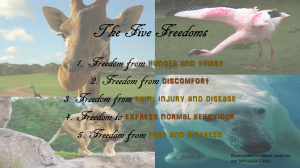The Five Freedoms is a subjective and qualitative measure of animal welfare, originating from the 1965 “Brambell Report”, with some revisions over the years culminating in this.
With major consensus, the Five Freedoms are as follows:
- Freedom from Hunger and Thirst: by ready access to fresh water and a diet to maintain full health and vigor.
- Freedom from Discomfort: by providing an appropriate environment including shelter and a comfortable resting area.
- Freedom from Pain, Injury or Disease: by prevention or rapid diagnosis and treatment
- Freedom to Express Normal Behavior: by providing sufficient space, proper facilities and company of the animal’s own kind.
- Freedom from Fear and Distress: by ensuring conditions and treatment which avoid mental suffering.
(Michigan State University Extension)
The Five Freedoms have been adopted by international organisations, including the Royal society for Prevention of Cruelty to Animals, as a criterion for animal welfare, and should be the fundamental ethos for zoos and other organisations involved with animals.

